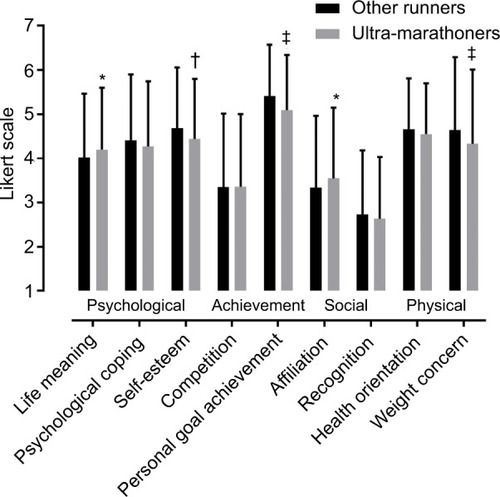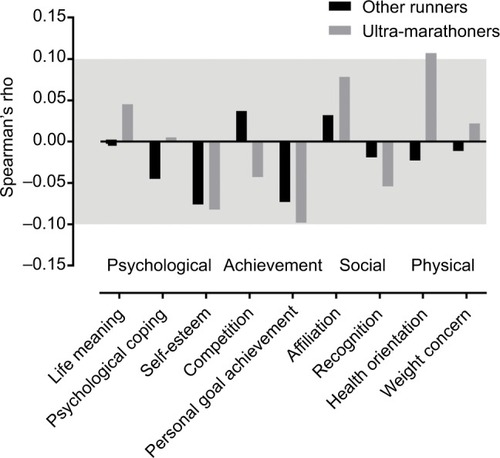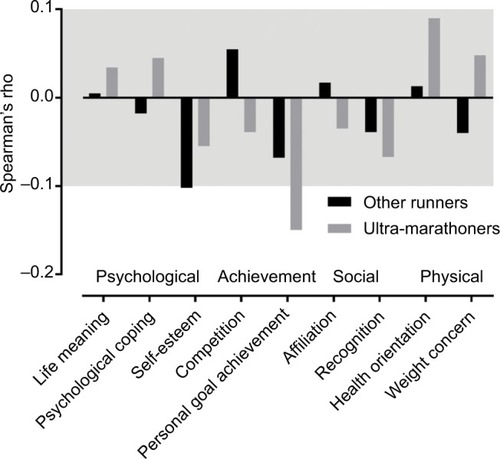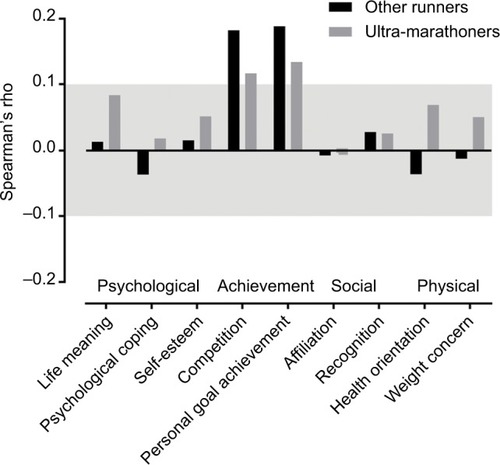Abstract
Background
In ultra-marathon running the proper motivation of the athlete is one of the milestones, not only during the races, but also during the practice sessions, which are long and very exhausting.
Purpose
The aim of this study was to examine the relationship of sport experience (expressed as number of finishes in ultra-marathons) with motivation characteristics of ultra-marathon runners.
Subjects and methods
The Motivation of Marathoners Scale examined the motivation of ultra-marathon runners compared to endurance runners of shorter distances (control group). Participants were 1,539 Polish runners, 382 women (24.7%) and 1,157 men (75.3%). Ultra-marathoners (N=425; 26.7%) finished at least one ultra-marathon, whereas the control group consisted of runners of shorter distances (N=1,114, 72.3%).
Results
Ultra-marathoners had higher scores in affiliation (3.55±1.60 vs 3.34±1.62, P<0.05), life meaning (4.20±1.40 vs 4.03±1.44, P<0.05) and lower in the areas of weight concern (4.33±1.68 vs 4.64±1.65, P<0.01), personal goal achievement (5.09±1.25 vs 4.64±1.65, P<0.001) and self-esteem (4.44±1.36 vs 4.68±1.38, P<0.01), than runners in the control group. The number of completed ultra-marathons was negatively related to the personal goal achievement, competition and recognition scale. The level of training experience was negatively correlated with the personal goal achievement scale in all participants, and with the self-esteem scale in the control group. In summary, ultra-marathoners had different motivations compared to runners of shorter race distance.
Conclusions
These findings should be considered by sport psychologists and other professionals to develop performance-tailored interventions for ultra-marathoners.
Introduction
Traditional recreational running is very popular around the world but parallel to this interest in running of moderate intensity, there is a growing participation in very intense running,Citation1 such as ultra-marathon events, which demand very good physical conditions and great mental preparation.Citation2 Indeed, the number of runners participating in ultra-marathon events reaches more than one hundred thousand participants in more than a thousand races around the world.Citation3 The number of people who finished an ultra-marathon race in the world in 2016 was 276,535, an amount that has doubled since 2011.Citation4
Ultra-marathon running includes all running events exceeding 42,195 km ie, the classical Olympic marathon distance. An ultra-marathon starts from 50 km and finishes in multi-day races, which may last 10 days. Races are held most often on trails with special events in high mountains, while others are held on asphalt roads lasting from 2–10 days.Citation5–Citation8 Given the increase in participation to such highly demanding races, it is important to understand what motivates ultra-marathon runners.
The originality and specificity of ultra-endurance races has attracted the attention of scientists from many areas from social sciences to sports medicine.
Extreme conditions and exhausting efforts allow the human body to attain very high levels of abilities for physical performance and mental toughness. Most recent studies analyzed energetic, dietary and water intake influence on runners,Citation9 heart rate variability, cardiac autonomic modulation and psychological correlates,Citation10 articular cartilage assessment,Citation11 use of non-steroidal anti-inflammatory drugs,Citation12 diarrhea problems,Citation13 injuries and health considerations,Citation14 nausea,Citation15 and gastrointestinal symptoms.Citation16 Relatively well-known already are the somatic characteristics of ultra-marathon participants’Citation17 or the influence of ultra-running on different biomarkers characterizing the decreased body homeostasis,Citation18–Citation20 or even skin manifestation of systemic disease during races.Citation21 Scientists also tried to understand the intentions and behavior of athletes during competition, nationality aspects,Citation22 gender differences,Citation23 how the habitual motives change during the lifeCitation24 and the use of medication during the competition.Citation25
However, a relatively small number of research projects have examined the motivation of ultra-marathoners during the races and preparatory periods. The most popular is the Motivation of Marathoners Scale (MOMS),Citation26,Citation27 which measures different motives of marathon runners. There is a specific gap in the existing scientific literature related to experience of athletes, their weekly training involvement and its influence on motivation structure and detailed characteristics. There is also a lack of in-depth analysis if participation in marathons and ultra-marathon changes personal models of motivation for running and practicing.
Motivation is one of the most important issues in sport psychology. In many sports well-motivated athletes may reach levels of performance higher than expected based on medical testing. In ultra-marathon running the proper motivation of the athlete is one of the milestones, not only during the races, but also during the practice sessions, which are long and very exhausting. The proper knowledge about the motives, which push them to their limits, would be very fruitful for athletes, coaches and sport psychology experts.
The aim of this study was to determine the relationship between ultra-marathon experience (ie, described as participation in ultra-marathons) and the motivation characteristics of the subjects. There was also an attempt to describe the relationship between both running experience and training frequency with motivation in ultra-marathon finishers (UMF) and people who had training experience but never started in an ultra-marathon. It was hypothesized that runners with ultra-marathon experience would have different level of motivation scales and the longer running history with higher frequency of training would change the relationship with the motivational characteristic of the subjects.
Methods
This is a comparative cohort study involving two groups of nonprofessional runners. This study examines whether sport experience is related to runners’ motivation.
Survey respondents
Respondents were 1,539 Polish runners with 382 women (24.7%) and 1,157 men (75.3%). Most of them ie, 1,114 (72.3%) never participated in any ultra-marathon (control group, CG), while 425 (26.7%) finished at least one. UMF consisted of 243 runners who finished from one to three ultra-marathons (57.2%), 127 with four to ten participations (29.9%) and 55 runners who finished more than ten ultra-marathons (12.9%). As an ultra-marathon race we accepted any event with a distance longer than Olympic marathon distance ie, 42.195 km. The number of runners in specific age groups is presented in .
Table 1 Control group and ultra-marathon finishers group distributions depending on age
Procedures
The participants were reached by the professional running web pages and by the websites of the marathon organizers. All of them were provided with information describing the study subject. Respondents who agreed to participate in the research used the link to the online questionnaire and were then transferred to the Google Docs system, where they anonymously answered the questions. It took the participants approximately 10–15 minutes to complete the full questionnaire. Respondents were also informed that they took part voluntarily in the study and that withdrawal was allowed at any time. Regarding the questionnaire, all information about the intended research was included in an invitation paragraph, which appeared on the welcome screen of the questionnaire and included all the necessary elements of traditional information sheet. The survey was anonymous and confidential.
Questionnaire and Reliability of MOMS
MOMS is a questionnaire, which allows determining the motivation of runners.Citation26,Citation27 It includes 56 questions divided into four main categories, which contain nine scales. Psychological category includes life meaning, psychological coping, and self-esteem. Achievement contains competition and personal goal achievement scale. The last two main areas cover social (ie, affiliation and recognition) and physical components (ie, health orientation and weight concern).Citation26 The 56 questions of the MOMS are rated on a 7-point Likert-type scale where “1” means “not a reason”, while “7” is valued as “a most important reason”. Masters et al (1993) evaluated the reliability on the basis of internal consistency from 0.80 to 0.93 and temporal stability of the nine factors after 3 months delayed evaluation ranged from 0.71 to 0.90.
Statistical methods
The basic descriptive statistics and Kolmogorov–Smirnov tests were performed to describe the sample and test the normality of distribution of all motives. In order to determine the relationships between training experience and motives, Mann–Whitney U test and Spearman rank correlation coefficients were calculated. The significance of the association (contingency) between the two kinds of classification was examined using Fisher’s Z test. Statistical significance was set at α=0.05 level. All statistical calculations were performed using SPSS Statistics 24 (IBM Corporation, Armonk, NY, USA).
Ethical approval
All the procedures were performed according to Polish law and were evaluated by the Bioethical Committee at Jerzy Kukuczka Academy of Physical Education in Katowice, which granted official approval (KB/47/17).
Results
The characteristic of non-starters and UMF frequencies in specific characteristics related to training experience and starting performance is presented in . It showed that UMF have a longer training experience, train more frequently and finished more marathons than non-starters.
Table 2 Non-starters and ultra-marathon finishers frequencies in specific characteristics related to training experience and starting performance
Descriptive statistics of MOMS are provided in . The Kolmogorov–Smirnov tests showed that the distributions of the variables differed from the normal distribution. It can be assumed that the distribution is not significantly asymmetrical because the skewness values are included in the range between –2 and +2. Cronbach’s alpha coefficients showed that the reliability of the subscales of the MOMS were good. Specifically, coefficients were 0.87 in case of life meaning, 0.92 for psychological coping and 0.88 for self-esteem. Concerning achievement, the competition subscale presented a coefficient of 0.87, and 0.81 for personal goal achievement. Affiliation scale had an alpha coefficient of 0.92, and recognition 0.89. Similar levels of alpha coefficients were observed for health orientation (0.81) and weight concern (0.83).
Table 3 Basic descriptive statistics of MOMS scales in control group and ultra-marathon finishers group
Because of the highly unequal samples in the two compared groups, non-parametric analyses were performed using the Mann–Whitney U test. As can be seen in , there were five statistically significant differences. People running ultra-marathons reported higher scores on affiliation and life meaning than person not running ultra-marathons (CG), and lower scores in the areas of weight concern, personal goal achievement and self-esteem.
Figure 1 Comparison of motivations between ultra-marathon runners and control group.

In the next step, we checked whether the number of completed races was related to motivation for CG and UMF Group (). Spearman’s rank (Spearman’s Rho) correlation analyses were performed and four statistically significant correlations were recorded. The number of completed marathons was negatively related to the personal goal achievement in CG (r=−0.073, P=0.015) and in UMF (r=−0.098, P=0.048). In addition, the number of finished marathons in UMF correlated positively with the health orientation scale (r=0.107, P=0.028) and in CG negatively with the self-esteem scale (r=−0.076, P=0.011). Fisher’s tests carried out in the next step showed again the existence of only one statistically significant difference (Z=−2.28, P=0.023). The relationship of the number of marathons completed with the health orientation scale was positive in UMF, while in CG it was negative and the value of the correlation coefficient was close to zero. Also the number of completed ultra-marathons was negatively related to the personal goal achievement (r=−0.134, P=0.006), competition (r=−0.097, P=0.046) and recognition scale (r=−0.104, P=0.033).
Figure 2 Relationship between motivations and number of finished marathon races.

The next correlation analysis allowed checking whether the training experience was related to the level of motivation in the ultra-marathon (). In both groups—UMF (r=−0.068, P=0.023) and CG (r=−0.150, P=0.002)—the level of training experience was negatively correlated with the personal goal achievement scale, while in the non-starters group also with the self-esteem scale (r=−0.102, P=0.001). In the case of the remaining pairs of variables, no close correlation of statistical significance was noted. Fisher’s tests carried out showed no statistically significant differences or even close to statistical significance. CG and UMF frequencies analysis showed that UMF are more experienced runners especially with more than 10 years of experience (22.4% vs 7.5%) and in “four to ten years” categories (57.6% vs 45.1%). CG were more often represented in group practicing “less, than a year” (5.4% vs 0.2%) and “one to three years” (41.9% vs 19.8%)
Figure 3 Relationship between motivations and years of training experience.

The examination whether the frequency of training sessions is related to the level of motivation in the tested groups showed four statistically significant correlations (). In both groups, there were positive relationships between the training frequency (r=0.188, P<0.001 and r=0.134, P=0.006) and the personal goal achievement (r=0.182, P<0.001 and r=0.117, P=0.016) and competition scales. CG and UMF frequencies analysis showed, that UMF were practicing more often, than CG especially in groups of runners with four to six training sessions per week (64.4% vs 52.2) and everyday trainings (9.4% vs 4.2%). CG runners practiced more often only in one to three training sessions per week (43.3% vs 26.1).
Discussion
It is clearly visible that the results of the correlation coefficients, and hence the strength of the relationships, were small, but the relationships described in the results were statistically significant. Statistical inference in accordance with the research methodology, based on a statistically significant correlation can be done, especially when the great advantage of our research was the sample size owing to which it is possible to prove the statistical significance of even weak links between variables, which is particularly important when analyzing relationships for data about often-subjective characteristics that are quantified in the form of rank scales.
The acquired data and its analysis showed that successful finishers in an ultra-marathon were characterized by statistically significant higher scores on affiliation and life meaning, and lower than the CG in the areas of weight concern, personal goal achievement and self-esteem. The number of completed marathons was negatively related to the personal goal achievement in both groups, while in successful finishers in an ultra-marathon it correlated positively with the health orientation scale and in the CG negatively with the self-esteem scale. The number of completed ultra-marathons was negatively related to the personal goal achievement, competition and recognition scale. In both groups—successful finishers in an ultra-marathon and CG—the level of training experience was negatively correlated with the personal goal achievement scale, and also in the CG with the self-esteem scale. In both groups, there were positive relationships between the training frequency and both the personal goal achievement and competition scales.
The main finding of the present study was that successful ultra-marathoners differed in motivation from runners of shorter distance. This was in agreement with a previous study comparing finishers in the “Marathon des Sables” (230 km) and other endurance and ultra-endurance runners.Citation28 For instance, finishers in the “Marathon des Sables” scored lower for competition and higher for nature and life meaning than marathon runners. It seems that runners competing in longer ultra-marathons compete more for life meaning than their shorter distance counterparts.
This is not the first study to examine psychological characteristics in ultra-marathoners compared to runners of shorter distance. For instance, a comparison among ultra-marathon runners, runners of less than 10 miles and non-runners indicated no difference in personality traits.Citation29
Only two papers focused on motivation in ultra-marathon, but they also have some limitations. Hanson et alCitation30 contrasted ultra-runners with half and full marathon runners. They found that ultra-marathoners showed significantly lower on health orientation and weight concern while higher on life meaning in relation to both diagnosed group and lower on personal goal achievement in relation to full marathoners. Krouse et alCitation31 used MOMS to evaluate ultra-runners’ motivation, but they administered the test only to female athletes. They found that highest motives for running were related to personal goal achievement and health orientation followed by self-esteem.
This study provides new insights in the difference between successful UMF and runners competing in shorter race distances. Little is known about non-finishers in ultra-marathonsCitation32 but we have no knowledge about runners competing in shorter race distances and non-finishers. Often, successful UMF have a large previous experience in ultra-marathon running.Citation33 In particular, successful ultra-marathoners have a fast personal-best marathon time.Citation34
A limitation of the present study was that ultra-marathon running was considered as a single sport event and differences in motivation among runners in events varying for distance or time were not examined. It has been previously observed that the age of ultra-marathoners increases as the distance gets longerCitation34 thus, it is reasonable to assume that motivation might vary among ultra-marathon runners of different distances. Consequently, our findings should be generalized with caution from one ultra-endurance distance to another. There is also a limitation, which may be an interesting direction for future research, to determine the motivation in ultra-marathoners and runners in shorter distances in relation to their sex. In our study there was some imbalance with the quantity of men and women so we decided not to split results to sex groups. Furthermore, the strength of the study was its novelty; there are only two scientific papers examining motivation in such a large number of endurance and ultra-endurance runners. Considering the increased number of ultra-marathon races and finishers during previous years,Citation35,Citation36 and the importance of motivation for performance in this sport,Citation37 the findings have practical applications for practitioners in this field, such as sports scientists and psychologists.
Conclusion
This study showed that successful ultra-marathoners had higher scores in affiliation and life meaning, and lower scores in the areas of weight concern, personal goal achievement and self-esteem than runners competing in shorter race distances. The number of completed marathons was negatively related to the personal goal achievement in both groups, correlated positively with the health orientation scale in ultra-marathoners and negatively with the self-esteem scale in runners competing in shorter race distances. The number of completed ultra-marathons was negatively related to the personal goal achievement, competition and recognition scale. In summary, ultra-marathon runners had different motivations from runners of shorter race distance. Sport psychologists and other professionals preparing runners for ultra-marathon should consider these findings.
Disclosure
The authors report no conflicts of interest in this work.
References
- HoffmanMDOngJCWangG Historical analysis of participation in 161 km ultramarathons in North America Int J Hist Sport 2010 27 11 1877 1891 20684085
- HughesSCaseHSStuempfleKEvansD Personality profiles of iditasport ultra-marathon participants J Appl Sport Psychol 2003 15 3 256 261
- The International Association of Ultrarunners (IAU). [webpage on the Internet] Available from: http://www.iau-ultramarathon.org Accessed December 12, 2018
- HoffmanMDKrouseR Ultra-obligatory running among ultramarathon runners Res Sports Med 2018 26 2 211 221 29378427
- MilletGYTomazinKVergesS Neuromuscular consequences of an extreme mountain ultra-marathon PLoS One 2011 6 2 e17059 21364944
- KnechtleBRüstCARosemannTLepersR Age-related changes in 100-km ultra-marathon running performance Age 2012 34 4 1033 1045 21796378
- WaśkiewiczZKłapcińskaBSadowska-KrępaE Acute metabolic responses to a 24-h ultra-marathon race in male amateur runners Eur J Appl Physiol 2012 112 5 1679 1688 21879351
- KłapcińskaBWaśkiewiczZChrapustaSJSadowska-KrępaECzubaMLangfortJ Metabolic responses to a 48-h ultra-marathon run in middle-aged male amateur runners Eur J Appl Physiol 2013 113 11 2781 2793 24002469
- MartinezSAguiloARodasLLozanoLMorenoCTaulerP Energy, macronutrient and water intake during a mountain ultramarathon event: the influence of distance J Sports Sci 2018 36 3 333 339 28322630
- RundfeldtLCMaggioniMACokerRH Cardiac autonomic modulations and psychological correlates in the Yukon Arctic Ultra: the longest and the coldest ultramarathon Front Physiol 2018 9 35 29483874
- SchützUHBillichCSchossDBeerMEllermannJ MRI cartilage assessment of the subtalar and midtarsal joints during a transcontinental ultramarathon – New insights into human locomotion Int J Sports Med 2018 39 1 37 49 29190850
- MartínezSAguilóAMorenoCLozanoLTaulerP Use of non-steroidal anti-inflammatory drugs among participants in a mountain ultramarathon event Sports 2017 5 1 11
- SubediY Around Manaslu ultramarathon: diarrhea is still the king Wilderness Environ Med 2017 28 4 375
- HoffmanMD Injuries and health considerations in ultramarathon runners Phys Med Rehabil Clin N Am 2016 27 1 203 216 26616184
- StuempfleKJValentinoTHew-ButlerTHechtFMHoffmanMD Nausea is associated with endotoxemia during a 161-km ultramarathon J Sports Sci 2016 34 17 1662 1668 26707127
- CostaRJSnipeRCamões-CostaVScheerVMurrayA The impact of gastrointestinal symptoms and dermatological injuries on nutritional intake and hydration status during ultramarathon events Sports Med Open 2016 2 1 16 26767151
- BelliTMeirelesCLSCostaMOAckermannMAGobattoCA Somatotype, body composition and performance in ultramarathon Rev Bras Cineantropom Desempenho Hum 2016 18 2 127 135
- BenedettiSCatalaniSPedaFLuchettiFCitarellaRBattistelliS Impact of the 24-h ultramarathon race on homocysteine, oxidized low-density lipoprotein, and paraoxonase 1 levels in professional runners PLoS One 2018 13 2 e0192392 29394290
- LiLHChenCTKaoWF Procalcitonin variation before and after 100-km ultramarathon Clin Chem Lab Med 2017 55 6 e110 e112 27718487
- ArakawaKHosonoAShibataK Changes in blood biochemical markers before, during, and after a 2-day ultramarathon Open Access J Sports Med 2016 7 43 50 27186145
- DescampsVClaessensYEDoumencBDoc Trotters Skin manifestations in ultramarathon runners: experience in the Marathon des Sables 2014 Br J Dermatol 2017 177 2 562 563 27861724
- KnechtleBRüstCARosemannT The aspect of nationality in participation and performance in ultra-marathon running – A comparison between “Badwater” and “Spartathlon” OA Sports Med 2013 1 1 1
- FrickB Gender differences in competitive orientations: Empirical evidence from ultramarathon running J Sports Econ 2011 12 3 317 340
- StollOWuerthSOglesB Teilnahmemotive von Marathon- und Ultra-marathonlaeufern/Participation motives of marathon and ultramarathon runners Sportwissenschaft 2000 30 54 67
- DidierSVauthierJCGambierNRenaudPChenuelBPousselM Substance use and misuse in a mountain ultramarathon: new insight into ultrarunners population? Res Sports Med 2017 25 2 244 251 28114830
- MastersKSOglesBMJoltonJA The development of an instrument to measure motivation for marathon running: the Motivations of Marathoners Scales (MOMS) Res Q Exerc Sport 1993 64 2 134 143 8341836
- OglesBMMastersKS Older vs. younger adult male marathon runners: Participative motives and training habits J Sport Behav 2000 23 130 143
- DoppelmayrMMolkenthinA Motivation of participants in adventure ultramarathons compared to other foot races Biol Sport 2004 21 4 319 323
- McCutcheonLEYoakumME Personality attributes of ultramarathoners J Pers Assess 1983 47 2 178 180 16367603
- HansonNMLDickeJBuckworthJ Motivational differences between half, full and ultramarathoners J Sport Behav 2015 38 2 180 191
- KrouseRZRansdellLBLucasSPritchardM Examining motivation, goal orientation, coaching, and training habits of female ultrarunners J Strength Cond Res 2011 25 10 S2835 S2842
- SchützUHBillichCKönigK Characteristics, changes and influence of body composition during a 4486 km transcontinental ultramarathon: results from the TransEurope FootRace mobile whole body MRI-project BMC Med 2013 11 1 122 23657091
- KnechtleBValeriFNikolaidisPTZinggMARosemannTRüstCA Do women reduce the gap to men in ultra-marathon running? Springerplus 2016 5 1 672 27350909
- KnechtleBKnechtlePRosemannT Race performance in male mountain ultra-marathoners: anthropometry or training? Percept Mot Skills 2010 110 3 Pt 1 721 735 20681327
- NikolaidisPTKnechtleB Performance in 100-km ultra-marathoners – At which age it reaches its peak? J Strength Cond Res Epub 2018 2 27
- NikolaidisPTKnechtleB Age of peak performance in 50-km ultra-marathoners – is it older than in marathoners? Open Access J Sports Med 2018 9 37 45 29535560
- MilletGYHoffmanMDMorinJB Sacrificing economy to improve running performance-a reality in the ultramarathon? J Appl Physiol 2012 113 3 507 509 22492933

